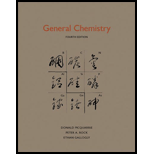
Interpretation:
Rate law and rate constant of the given reaction has to be determined.
Concept Introduction:
Rate of a reaction depends on the species concentration that takes place in the reaction.
Answer to Problem 17.28P
Rate law of the reaction is
Explanation of Solution
Given reaction is:
Rate of the reaction is measured using the change in pressure. The total pressure that is reached after
By Dalton’s law of partial pressure, the total pressure at any time of the reaction can be given by the equation shown below:
Quantity of oxalic acid that undergoes the reaction is directly proportional to
For one mole of
For one mole of
Substituting these values in equation (1) as shown below:
Rearranging the above equation in terms of
Solving for
Considering the reaction to be first order, the rate law of the reaction can be given as follows:
Substituting the values in equation (2), the rate constant for the reaction is calculated as shown below:
Thus the rate constant of the reaction is
Want to see more full solutions like this?
Chapter 17 Solutions
General Chemistry
 ChemistryChemistryISBN:9781305957404Author:Steven S. Zumdahl, Susan A. Zumdahl, Donald J. DeCostePublisher:Cengage Learning
ChemistryChemistryISBN:9781305957404Author:Steven S. Zumdahl, Susan A. Zumdahl, Donald J. DeCostePublisher:Cengage Learning ChemistryChemistryISBN:9781259911156Author:Raymond Chang Dr., Jason Overby ProfessorPublisher:McGraw-Hill Education
ChemistryChemistryISBN:9781259911156Author:Raymond Chang Dr., Jason Overby ProfessorPublisher:McGraw-Hill Education Principles of Instrumental AnalysisChemistryISBN:9781305577213Author:Douglas A. Skoog, F. James Holler, Stanley R. CrouchPublisher:Cengage Learning
Principles of Instrumental AnalysisChemistryISBN:9781305577213Author:Douglas A. Skoog, F. James Holler, Stanley R. CrouchPublisher:Cengage Learning Organic ChemistryChemistryISBN:9780078021558Author:Janice Gorzynski Smith Dr.Publisher:McGraw-Hill Education
Organic ChemistryChemistryISBN:9780078021558Author:Janice Gorzynski Smith Dr.Publisher:McGraw-Hill Education Chemistry: Principles and ReactionsChemistryISBN:9781305079373Author:William L. Masterton, Cecile N. HurleyPublisher:Cengage Learning
Chemistry: Principles and ReactionsChemistryISBN:9781305079373Author:William L. Masterton, Cecile N. HurleyPublisher:Cengage Learning Elementary Principles of Chemical Processes, Bind...ChemistryISBN:9781118431221Author:Richard M. Felder, Ronald W. Rousseau, Lisa G. BullardPublisher:WILEY
Elementary Principles of Chemical Processes, Bind...ChemistryISBN:9781118431221Author:Richard M. Felder, Ronald W. Rousseau, Lisa G. BullardPublisher:WILEY





